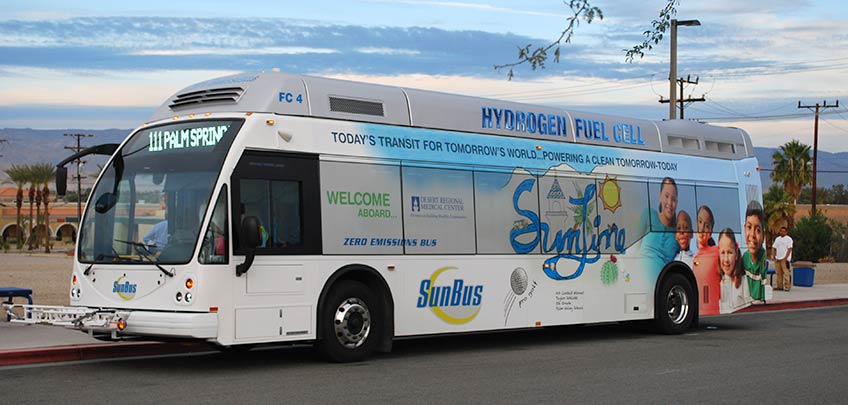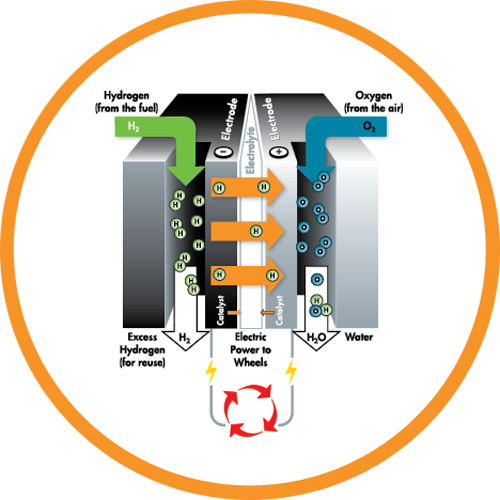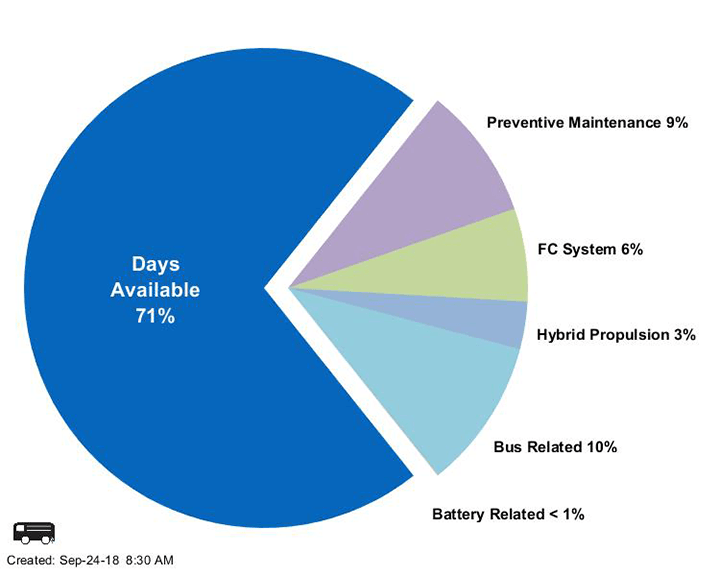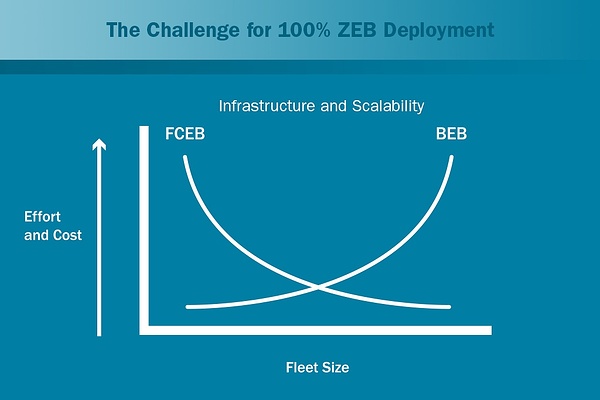Fuel Cell Electric Buses in the USA
June 25, 2019 by Laura Beshilas, NREL

Figure 1: American Fuel Cell Electric Bus. Photo by Leslie Eudy, NREL
In the United States, the average age of a full-sized transit bus in the United States is 7 years and the average retirement policy for 40-foot transit buses is 12 years. Therefore, many transit buses in the country are on track to be replaced. Conventional buses have substantial emissions and low levels of fuel efficiency.

Communities seeking to replace conventional transit buses have many options to consider. Some jurisdictions are considering fuel cell electric buses (FCEBs) to determine if they meet their needs. The NREL publication, Fuel Cell Buses in U.S. Transit Fleets: Current Status in 2018 (https://www.nrel.gov/docs/fy19osti/72208.pdf) by Leslie Eudy and Matthew Post provides a starting point for understanding the benefits and challenges of FCEBs as well as learning about communities that have placed FCEBs in service.
Fuel Cell Electric Bus Technology
A FCEB is a transit bus that utilizes fuel cell technology. A fuel cell combines hydrogen and oxygen to produce electricity, heat and water. The electricity created powers the bus’s electric motor.
Fuel cell buses are fueled at hydrogen fueling stations using a flexible hose and nozzle, just like refueling at a gas station. It takes about 10 minutes to fuel a FCEB. Hydrogen can be generated at the fueling site or produced elsewhere and delivered to the fueling station.
Fuel Cell Bus Status in the USA, 2018

Every year since 2000, NREL has studied and evaluated fuel cell transit buses. These analyses summarize the progress of fuel cell electric bus development and deployment in the United States providing information about FCEB performance (i.e., lifetime, range, fuel economy, operation time, and availability) as well as FCEB costs (i.e., bus cost, scheduled and unscheduled maintenance costs). The studies focus on five FCEB demonstrations – four in California and one in Ohio. The information below comes from the latest report, unless otherwise specified.
FCEB Trends
Availability: Availability is measured as the number of days buses are actually available to run compared to the number of days planned for operation. The 2018 evaluation found that FCEBs have an average availability of ~71%. Comparatively, compressed natural gas conventional buses from the study fleets had an average availability of ~85%. The study tracked reasons for unavailability, as seen in Figure 4. Bus-related problems made up the most unavailable days for the FCEB. These include brake, suspension, air system, and air conditioning issues.
Purchase Cost: The cost of FCEBs is declining. The average cost of a bus is $1.27 million, which is 49% lower than buses purchased in 2010. The price is projected to decrease to $850,000 per bus in the next two years.

Scalability: Adding FCEBs to an established FCEB fleet does not require adding additional charging infrastructure, which is required when adding battery electric buses (BEBs) to a fleet. Though it might be more expensive to start an FCEB fleet due to the construction of a hydrogen fueling station and the bus purchase price, the long-term effort and cost decreases as fleet size increases.
Fuel cell life: The longest operating fuel cell has over 31,000 hours of service. This is similar to the half-life of a diesel engine, the point in the diesel engine’s operating life at which the engine often needs refurbishment.
Fuel Economy: Compared to conventional bus technology, FCEBs have a higher fuel economy. The fuel economy for one fleet studied, the Orange County Transit Authority American Fuel Cell Bus, had a fuel economy 1.8 times the authority’s conventional buses.
Challenges of FCEB
Cost: Though the average cost of an FCEB is decreasing, the cost is not currently competitive with other bus technologies. An average conventional diesel 40-foot bus costs between $460,000 to $490,000 and an average compressed natural gas bus costs between $540,000 to $580,000 (compared to $1.3 MM today and $850,000 in two years).
Fuel Cell System Issues: Most problems with the fuel cell system are due to components of the balance of plant, like air blowers and compressors. Balance of plant components are the parts that help the hydrogen fuel stack function properly, they do not make up the fuel stack itself (which is more reliable than the balance of plant).
Parts Supply: Fleet operators have experienced difficulties getting parts. Agencies have addressed this issue by producing the parts internally or by ordering parts directly from a manufacturer rather than using a distributor. Future FCEBs are planned to have parts that can be replaced with conventional bus parts, improving availability and lowering costs.
Range Issues: FCEB operators have reported difficulties in completely filling hydrogen tanks, and bus range depends on the ability to fill the tank completely. Buses often run low on fuel before they finish scheduled routes because tank pressure drops due to hydrogen temperature changes. Therefore, buses are not getting as much fuel as is needed. Some operators have adjusted to this issue by topping off fuel tanks, which is not as efficient and wastes fuel. This can be avoided by increasing the fueling station pressure point so that when the hydrogen cools, it falls to the correct threshold.
Access to and Cost of Hydrogen Fuel: Hydrogen fuel is often expensive and difficult to access. Before introducing FCEBs, transit authorities should start working with a hydrogen fuel supplier as early as possible. In addition, transit authorities should plan for future fleet expansion to reduce future costs.
Summary
There are many benefits to introducing FCEBs into public transportation systems. FCEBs do not emit any pollutants which is good for air quality in already congested cities. They can replace conventional buses one to one – FCEBs have a similar range as conventional buses and do not need to be refueled as often as the battery electric buses that require charges during scheduled routes.
Many of the challenges facing FECBs will be reduced as technology advances and as the purchase price of FCEBs decline. Other challenges can be tackled with proper staff training. Training includes proper handling of different start-up and shut-down processes as well as different maintenance needs and failure procedures. In addition, dispatchers need to be trained in bus capabilities and troubleshooting.
NREL analyzes FCEB bus data annually. Check out the NREL Fuel Cell Electric Bus Evaluations and other resources listed below to keep up to date on FCEB technologies, learning opportunities, and the experiences of other communities.
Resources
American Public Transportation Association
Borrow a Bus Program – SARTA
Fuel Cell Electric Bus Evaluations – NREL
Hydrogen Production and Delivery – NREL
National Fuel Cell Bus Program – Federal Transit Administration
Share

